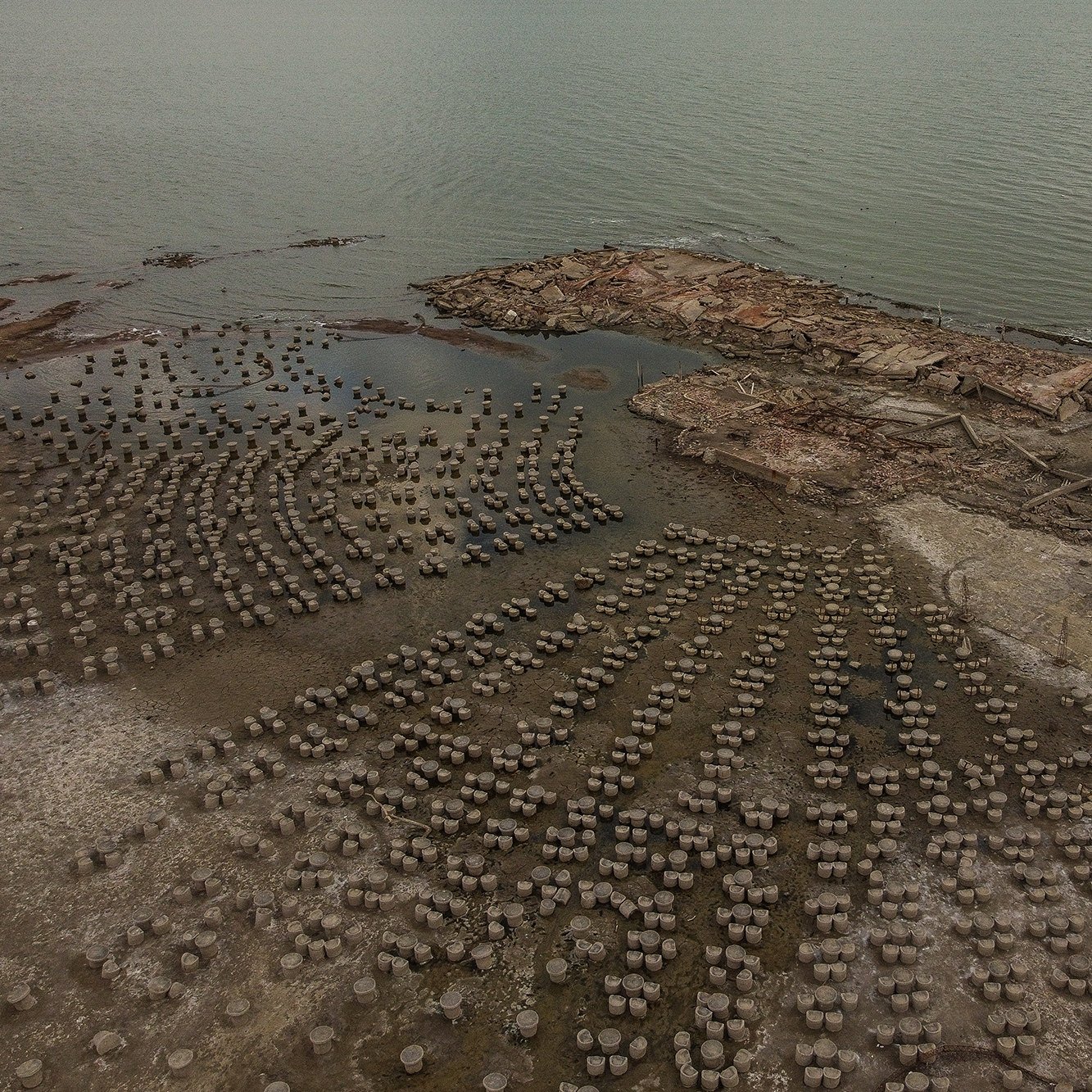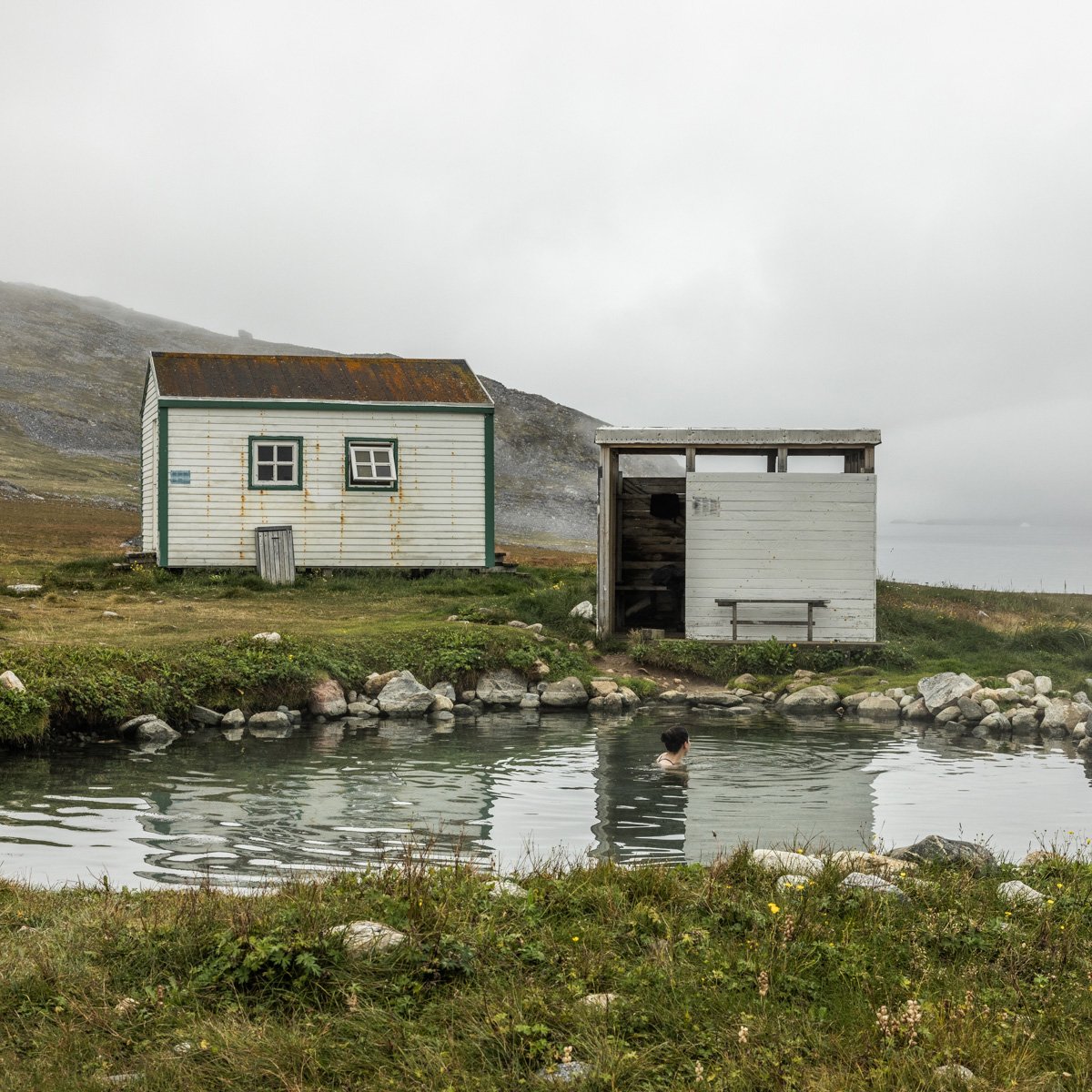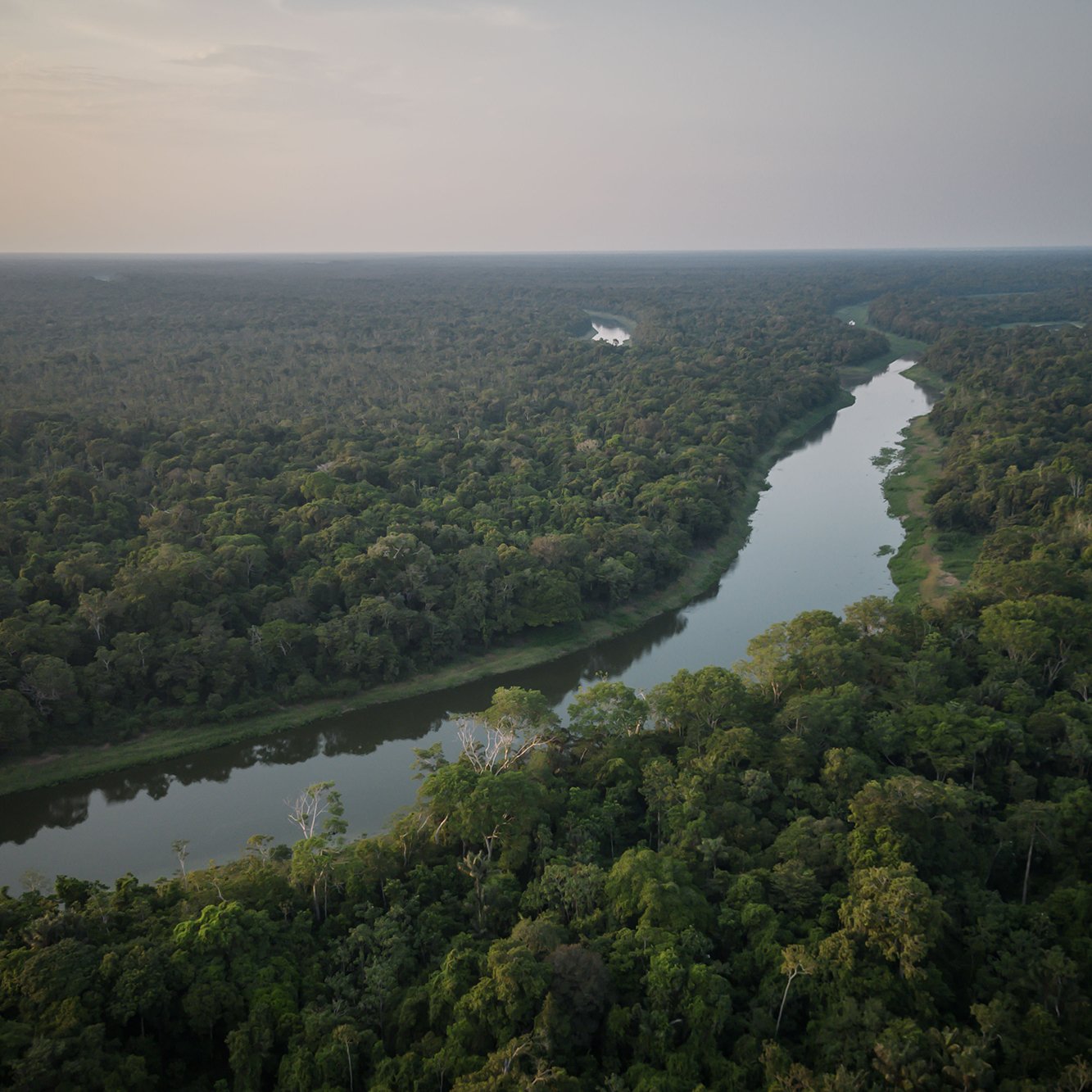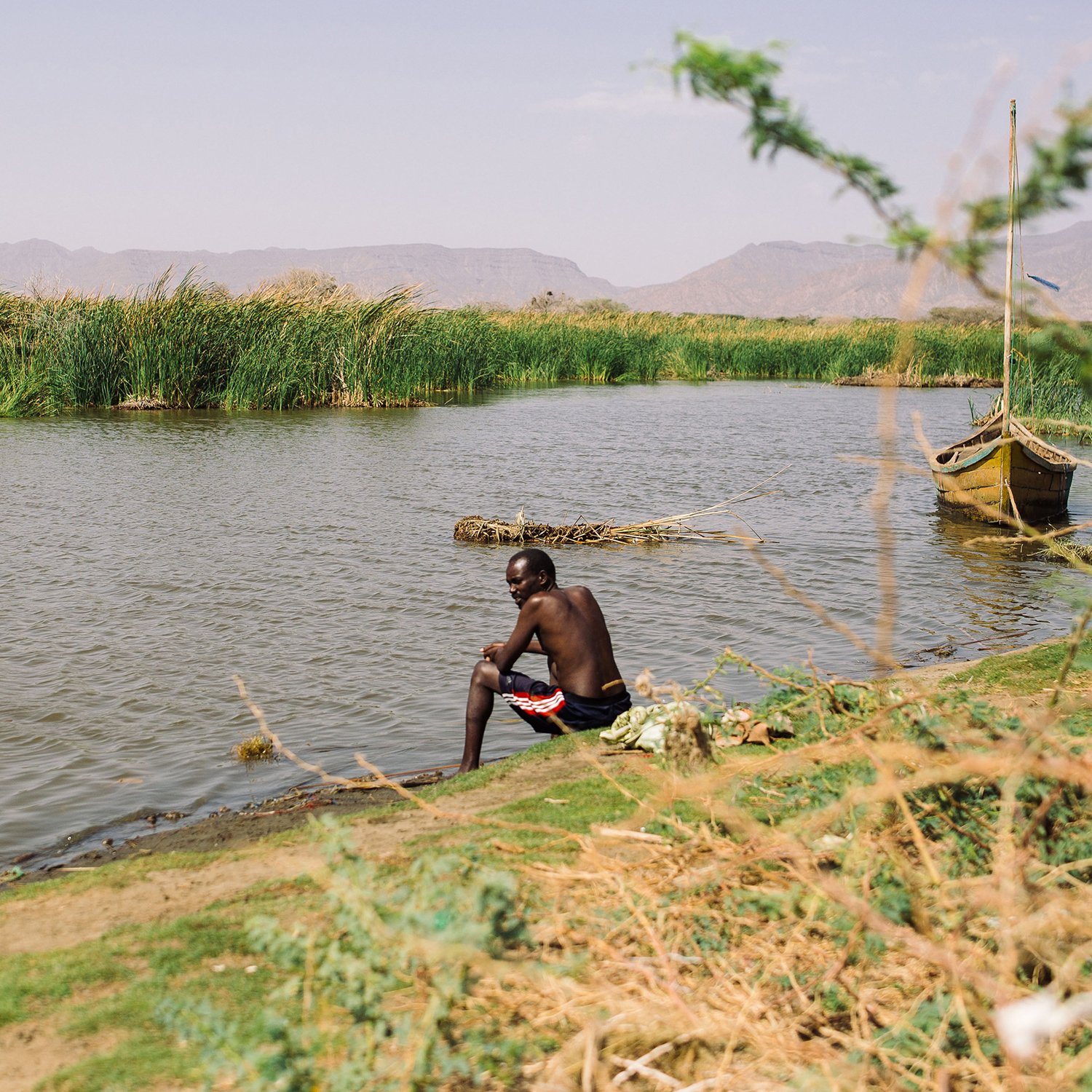The Rainforest Speaks
Scientists are recording the sounds of the Amazon in a bid to better protect it.
SEPTEMBER 5, 2024
Michel André tests bioacoustic technology during an installation for Project Providence in the Adolfo Ducke Forest Reserve, a protected area of 10,000 hectares (25,000 acres) bordering the city of Manaus. Photograph by Nicola Zolin.
He has tattooed forearms and a broad back, and walks through the Brazilian Amazon rainforest carefully, though he knows it like the back of his hand. On the return journey to the rabetinha — a small motorboat used for transport in the area — he stops. He begins to imitate the sound of the yacare caimans, the hungry reptiles that surround him. He says he wants to know if this relative of the alligator is near the boat. When he imitates their sounds, the creatures lift their shining red eyes in the darkness of the tropical forest and answer him with a similar cry. He changes his route to avoid them, and a slender snake crosses his path. Using a stick, he flicks it away with a practiced movement.
Izael da Silva, 42, works with scientists from Project Providence. Launched in 2017, this initiative attempts to record, in real time, the sounds of the Amazon rainforest in the nine countries it stretches across: Brazil, Peru, Colombia, Venezuela, Ecuador, Bolivia, Suriname, Guyana and French Guiana. By 2025, Project Providence hopes to study the impact of climate change and human activities on the Amazon biome using ultrasophisticated sound detectors.
Da Silva’s task for now is to recover a hard drive that contains the sounds the detectors captured. The small green box, equipped with a highly sensitive microphone, is located on the shore of Lake Mamirauá, a navigable body of water in the northern Brazilian state of Amazonas. This is where Project Providence began. Scientists have extended its reach to the 3 million hectares (7.4 million acres) that make up the Mamirauá Reserve, which is also home to 10,000 people from different Indigenous communities. Hundreds of birds fly over the area, producing a disordered symphony, like that of an orchestra without a conductor. All these sounds are registered on a tiny hard drive.
Da Silva, who comes from an Indigenous background, grew up in the community of Vila Alencar, one of 200 small towns on the reserve. He has lived several lives: As a teenager he fled from his native territory to the port near Tefé, 60 kilometers (37 miles) away. He didn’t have a formal education — to survive, he joined a gang that sold drugs, and he acted as the lookout when sales took place. He says he went to jail several times before his mother pulled him out of the gang. He doesn’t say anything more about that time. After leaving the gang, he became a tour guide. He reconnected with the nature he grew up in and went back to fishing and getting lost in the jungle, following the sounds of animals. Ten years ago, he was hired by a French scientist to accompany him through the Amazon.
Volunteers from the Mamirauá Reserve take turns keeping watch over their territory, where outsiders are prohibited from fishing or cutting down trees. Photograph by Nicola Zolin.
Michel André, 60, is a specialist in bioacoustics, the science of animal sounds. He is the director of the Laboratory of Bioacoustic Applications — or LAB, for its initials in Spanish — at the Polytechnic University of Catalonia. He has listened to the vibrations of nature for 30 years. The ex-gang member and the scientist, united by a love for the forest and its secrets, decided to collaborate. Da Silva “knows what he’s doing, and we who come from the outside can only be humble before that knowledge,” the scientist says in a solemn voice. To install the sound detectors, they traveled together through the tropical rains that characterize the region, sometimes crossing tumultuous rivers to access more remote areas, while avoiding what da Silva calls “the pirates of the Amazon” — people who attack boats to steal gasoline and anything else they can find, and often make attempts on the lives of the passengers, too.
André and da Silva joined forces with the Brazilian scientist Emiliano Ramalho, the director of the Mamirauá Institute and a specialist in bioacoustics. Meeting André inspired Ramalho to create Project Providence. One of every 10 known species in the world lives in the Amazon rainforest. Given the immense amount of work involved in studying the area, Ramalho decided the project would need to be a joint effort. And so, in 2017, a collaboration began between LAB and the Mamirauá Institute for Sustainable Development, with the help of da Silva. Others soon got involved in the project as well.
“This international collaboration is an incredible opportunity to bring together our different abilities to better protect the Amazon,” Ramalho says from his office in Manaus.
One of the units of Project Providence that was used to map the Mamirauá reserve. Photograph by Nicola Zolin.
The sounds of life
The U.S. sound engineer Bernie Krause is often considered to be the founder of bioacoustics, though he didn’t have a clear idea of what he was inventing. In the ’60s, he was a star among sound engineers and worked with celebrated musicians such as the Doors, Peter Gabriel and Brian Eno. While he was recording an album in the forests of California, he was astonished by the sounds that he heard in the background. He began to frenetically archive the sounds of 15,000 animal species, traveling from the frozen plains of Alaska to the depths of the ocean. Over more than 5,000 hours, these recordings helped establish a deeper understanding of animal behavior. And so the field of bioacoustics — and the profession of bioacoustic engineer — was born.
Thanks to this area of study, in the last few years scientists have discovered that near Barcelona, a particular kind of bat is crowding out the rest, and that in Canada, noise pollution from big cities is causing certain species of birds to lose weight and sing ever more loudly to attract mates. In Norway, the rhythm at which the glaciers melt is being tracked through sound.
“It is the study of the sounds of life,” André says. He and his team have made notable discoveries by researching the sounds of living organisms. In 2011, they were the first to find proof that human activity has caused acoustic trauma in dolphins. “They lose the ability to orient themselves, which prevents them from looking for food,” he explains.
The team also determined that some plants perceive sound, and that exposure to noise produced by humans can cause trauma that affects their survival. Acoustic contamination, for example, damages various tissues found in marine vegetation.
In the office of Project Providence in Manaus, the bioacoustic engineers Riuler Acosta, Lidiane Gomes and Camila Vieira look at a spectrogram, which shows the visual representation of a sound. The sounds of certain species, like the song of a bat, are inaudible to human ears. Photograph by Nicola Zolin.
The ambition of Project Providence is to carry out the largest-scale bioacoustic work in the history of the Amazon region. “Thanks to these intelligent ears, we can understand with increasing precision the forms of life that inhabit the forest, and find solutions to restore the balance that was lost,” André says.
The project involves recording sounds with detectors installed in the treetops and underwater, to compare the state of the ecosystem in different parts of the forest. “In Mamirauá, for example,” André says, “there are areas of the tropical forest that are practically isolated from human influence, which we are capturing and which serve as a pattern to compare with Manaus, where animal behavior has changed with the noise of traffic. That lets us see how the same ecosystem adapts to human influence.”
Manaus is the entrance to the Brazilian Amazon rainforest, a city that combines high-rise buildings and the chaotic sounds of traffic with vast protected areas of the ecosystem in which hundreds of animal species can be heard. A phase of Project Providence is being developed in the Adolfo Ducke Forest Reserve, a protected zone of 10,000 hectares to the north of the city.
“I think I’ll jump from here,” says a smiling Adilio Santos as he clings to a rope and prepares to climb a tree 25 meters (28 yards) tall. “This tree is perfect.” Santos, 45, and his inseparable colleague Edielton Sousa da Silveira, 42, are professional Brazilian mountaineers and tour guides from Corcovado, a mountain in Rio de Janeiro. In December, they completed a special mission to place sound detectors, fueled by photovoltaic panels, in the treetops — a task they carried out under a torrential downpour over the course of four hours. Sometimes the rain would stop, and clouds of mosquitos would arrive; the wind made the treetops sway dramatically.
The sound detectors installed by the two mountaineers, under the supervision of da Silva and André, use artificial intelligence. The goal is for the AI to distinguish among the different species of the forest, allowing them to be tracked individually.
To capture the sounds of the endangered animals native to the Amazon rainforest, the bioacoustic team installed a series of sound detectors in the zoo of Manaus. The sounds of these animals can help instruct artificial intelligence on how to identify different species. The health of the jaguar, an animal at the top of the food chain, is generally considered to be a measure of the health of the ecosystem. Its absence in the forest demonstrates that the ecosystem is in danger. Photograph by Nicola Zolin.
Artificial intelligence learns
Riuler Acosta, 29, Lidiane Gomes, 36, and Camila Vieira, 32, work on Project Providence from their office at the Mamirauá Institute, in the center of Manaus. They are observing a spectrogram, the visual representation of a sound. In this case, it is the fragment of a sound recorded in the Amazon, a “soundscape.”
Gomes slows down the recording, and as if by magic, the shriek of a bat, ordinarily inaudible to a human ear, fills the office. “We make the invisible visible,” she says.
The engineers enter the greatest possible number of rainforest sounds into a database: birdsong, rustles of leaves, rainfall on treetops, a jaguar’s roar, the deafening buzz of cicadas. The idea is for AI technology to identify individual species amid the confusion of noise in the rainforest.
Acosta, the youngest of the bioacoustic engineers, is passionate about insects. He has a large collection of WhatsApp stickers that range from a locust with a heart to a crying cicada. In the Federal University of Amazonas’ forest — a protected zone that covers 6.7 million square meters of Amazonian rainforest in the center of the city of Manaus — he captured the songs of different species of cicadas. Now Acosta is indexing them so the AI can identify them as well as he can.
Insects perform a crucial role in determining the health of an ecosystem. “They are the most diverse and numerous group of organisms,” Acosta explains. “They are responsible for most of the cycles of nutrients in the ground, the transport of seeds and pollination. Their absence can indicate bad environmental quality, whether because of the influence of chemical agents, fires, the trampling by livestock or urban light on their nocturnal activities.”
Tomé, 54, is the head of the group that keeps watch over the Mamirauá Reserve and teaches children in the area about the importance of preserving it. He remembers a time when Mamirauá was still unprotected, and poaching was an everyday occurrence. The pirarucu, a tender Amazonian fish, has almost entirely disappeared. Photograph by Nicola Zolin.
To capture the sounds of bigger animals and record a variety of important species, the bioacoustics team also visits the zoo of Manaus, where several local Amazonian animals are protected, often after being rescued from illegal wildlife trade. In December, the team installed sound detectors in the enclosures of a jaguar, an eagle and a panther, with the goal of training AI to later identify the sounds of these animals in their natural environment.
Starting from the individual tracking of species made possible by AI, the scientists aim to learn more about the biodiversity of the Amazon. “It is a long-term process, since there are still species in the Amazon that have not even been identified,” André says. The results obtained by scientists over years of investigation could help promote public policies that protect the rainforest.
“For example, there is an invasive lizard from Africa that arrived on a boat to Manaus,” Gomes says. “With Project Providence, we can track the impact it has on the ecosystem, listen to it and see if it reduces the sounds of other lizards and other species in its environment. Thanks to the data that we gather, the authorities will be able to decide if it is necessary to regulate the population of these African lizards in specific areas of the Amazon.”
André adds: “Our work is to gather data. Then we will put it at the disposal of other scientists and the authorities, who, thanks to this new information, will be able to develop public policies in the Amazon to protect certain species.”
Volunteers from the Mamirauá Reserve eat lunch together on their floating base in the river. Photograph by Nicola Zolin.
Protecting threatened communities
In the green heart of Mamirauá, where Project Providence was born, local communities hope the technology can also be used to detect illegal intrusions on the reserve. “The idea, beyond Project Providence, is to train artificial intelligence to detect threats like the noise of saws or motorboats in an area of the Amazon rainforest that the state wants to protect,” André explains.
Mamirauá obtained the status of sustainable development reserve from the state in 1996 and was the first of its kind. Since then, the inhabitants, who make a living from fishing and agriculture, have been recognized as the owners of their homes on the condition that they protect the territory. They are allowed to catch specific quantities of fish in authorized zones at specific times of year. The income from fishing is equally distributed among the local population. Those who do not live on the reserve are not allowed to fish there.
To prevent intrusions, communities have created a system to monitor the territory in shifts of 15 days. Volunteers take turns living in a wood house floating on Mamirauá Lake from which they keep watch. When night falls, they take lanterns and go out in a rabetinha. They take care to avoid the yacare caimans by making a continuous movement with the light, left to right. These animals, which can reach 2.5 meters in length and weigh more than 50 kilograms (110 pounds), could overturn the boat. Sometimes the volunteers find themselves surrounded by up to 30 of these creatures and pestered by the stings of flies. But Tomé, 54, and the three young volunteers who accompany him on the night shift are concentrated on watching their territory. “When they hear our boat arrive,” Tomé says, referring to those who clandestinely enter the reserve to fish, “they hide in the forest.”
The illegal intrusions in the territory multiplied during the term of former President Jair Bolsonaro, thanks to a lack of controls by the state, which also stripped funding from organizations that protect Indigenous communities. “They arrive with fleets of 20 boats, in groups of up to 50 people that can catch up to 100 kilograms of fish per vessel. In 2021, the police arrested some intruders who stole 780 kilograms of fish from us,” says Paulo Cavalcante, 40, the coordinator of the nine communities living in the Mamirauá area, as he pulls out his cellphone to look at images of poachers detected in the area. “The people come at night, so it isn’t easy to spot them. Unfortunately, despite the status of the reserve, it happens pretty often.”
Michel André, the director of the Laboratory of Applied Bioacoustics at the Polytechnic University of Catalonia, installs a sound recording unit in the Adolfo Ducke Forest Reserve, Manaus. Photograph by Nicola Zolin.
“Poachings were the order of the day before Mamirauá was turned into a reserve,” Tomé says. The giant arapaima, here called a “pirarucu,” has practically disappeared. The fish — known as the “cow of the Amazon” because of its tender flesh and large size — is a major source of food and income for these communities. It can measure up to 3 meters long and weigh more than 200 kilograms. To avoid its disappearance, inhabitants began to keep watch and enforce strict rules for fishing.
Project Providence developed underwater detectors to monitor threats to the species
and intervene whenever necessary. According to Cavalcante, who helped install the first acoustic equipment on the reserve, the bioacoustic team’s initiative is a source of hope. “We are attentive to Michel’s experiments and projects that can help us better safeguard this territory,” he says.
Among the nine countries that shelter the Amazon biome, 18 percent of the rainforest has been lost completely and an additional 17 percent has been damaged, according to a report from the Science Panel for the Amazon, a United Nations initiative that carried out the first exhaustive scientific evaluation of the Amazon in 2021 with the support of 200 scientists. More than 10,000 species of plants and animals run a high risk of extinction because of the destruction of their habitat.
Scientists agree on an alarming conclusion: The situation has reached a point of no return. The area could turn into savanna because of deforestation, which boosts the effects of climate change. This could occur when between 20 percent and 25 percent of the forest has been logged, according to the report.
Izael da Silva, 42, grew up in the Amazon rainforest and knows it like the back of his hand. When he was younger, he got involved with a drug trafficking gang, but he managed to leave that behind and became a tour guide. He works for Project Providence, helping the team find the best places to install solar sensors. Photograph by Nicola Zolin.
During Bolsonaro’s term, deforestation in the Amazon reached record figures: In 2022 alone, the Brazilian Amazon lost 10,267 kilometers (6,380 miles) of vegetal coverage, an area equivalent to that of a country like Lebanon, according to the National Institute for Space Research, a state-funded organization. In a radical departure from the politics of his predecessor, the government of the current president, Lula da Silva, has lowered deforestation by almost 50 percent in the first year of his term, according to the same organization.
Some 2.2 million Indigenous people from more than 500 different groups live in the Amazon rainforest and depend on it to sustain themselves. Lula has promised to protect the Amazon biome and the communities that inhabit the forest, and his government has contacted the scientists of Project Providence to develop a program that would use the same technology to protect communities threatened by illegal logging, illegal gold mining and other illicit activities.
“This means that authorities could react in real time to stop environmental delinquents,” André says. “In an Indigenous village, there would be a control center and thousands of acoustic detectors to monitor vast zones of the Amazon.”
The forest under surveillance
Lara, 5, looks at the drawing her sister made.
“My parents told me it eats children who don’t behave,” says Lara, who like all the children on the reserve is afraid of the Curupira, a mythological creature that has lived in the imaginations of Indigenous communities for generations. Considered the guardian of the rainforest, it has backward feet so that its tracks seem to distance themselves when in reality they are approaching. It tolerates those who hunt to eat but punishes those who do so without necessity, dismantling their traps and making them lose their way in the forest. Just like the Curupira, the scientists’ bioacoustic technology can be thought of — and used — as a protective ear that knows everything about the rainforest.
Zuzana Burivalova, a bioacoustic scientist who works on the efficiency of conservation techniques in the tropical forests, says there are limits to the technology’s ability to detect threats in real time: “It might permit communities to know what hour of the day and in what area people are cutting down trees, but to stop those people, one must have extremely precise information about where they are, since the forest is big and a satellite connection is hard to establish.” She adds that it also presents an ethical problem: “Do we want the whole forest to be monitored?”
Far from the rainforest, the most significant bioacoustic experience ever carried out is also one of the most criticized. In 2015, New York City installed more than 25,000 microphones to detect the sounds of gunshots. The technology, composed of detectors called “ShotSpotter gunfire sensors,” is thought to help authorities monitor the city, but the initiative is controversial, with critics arguing that it’s a form of surveillance.
Back in Mamirauá, André, Ramalho and their team, beyond trying to understand changes in animal behavior and pay attention to the cries of nature, are convinced that bioacoustic technology can help Indigenous communities defend their territories. “Once Michel finishes his project in the reserve, with a system able to detect intrusions, our survival will be guaranteed for many generations,” da Silva says. Steering the rabetinha, he says: “Be silent. Listen to what the forest wants to tell you.”
An aerial view of the Mamirauá Reserve. Photograph by Nicola Zolin.
This piece was made possible with the support of the Rainforest Journalism Fund, in collaboration with the Pulitzer Center. It first appeared in the Mexican magazine Gatopardo and was translated from Spanish by Jessica Sequeira.















